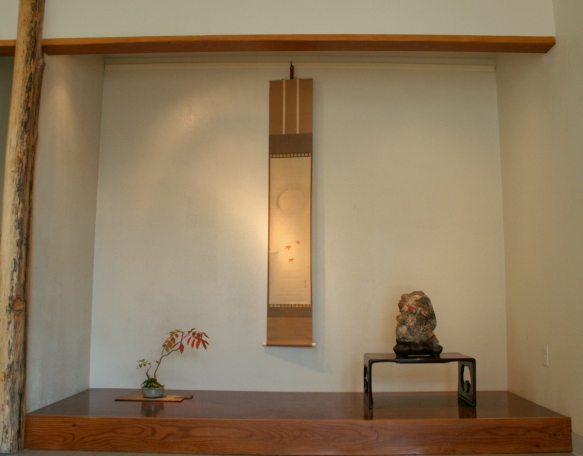 The first tokonoma display of fall is traditional three point display made up of a stone, a scroll, and an accent plant. A typical three point display contains a primary element that holds the visual weight of the space. This is typically a bonsai or viewing stone but can also be a scroll. The second element has less visual weight and can also be a bonsai, stone, or scroll.
The first tokonoma display of fall is traditional three point display made up of a stone, a scroll, and an accent plant. A typical three point display contains a primary element that holds the visual weight of the space. This is typically a bonsai or viewing stone but can also be a scroll. The second element has less visual weight and can also be a bonsai, stone, or scroll.
The third component can be an accent plant, small stone or some decorative art object like an okimono.
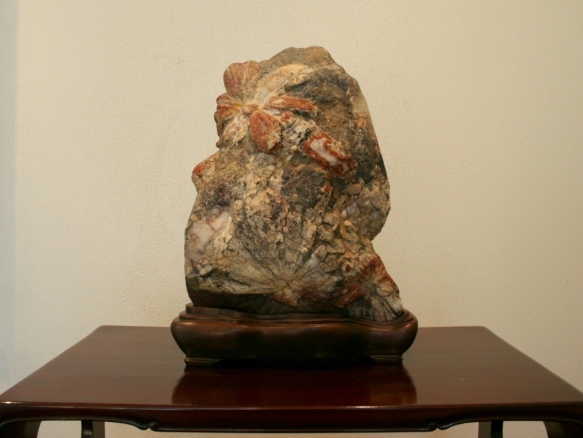 The primary element in this display is a Chrysanthemum stone from Sado Island donated by Ralph Johnson.
The primary element in this display is a Chrysanthemum stone from Sado Island donated by Ralph Johnson.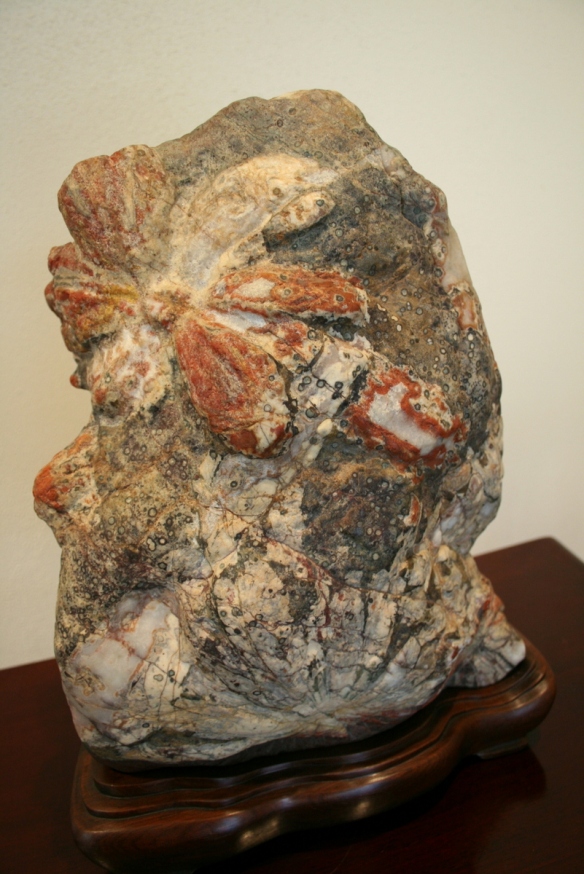 This close-up view of the stone shows the various mineral deposits within the stones matrix.
This close-up view of the stone shows the various mineral deposits within the stones matrix.
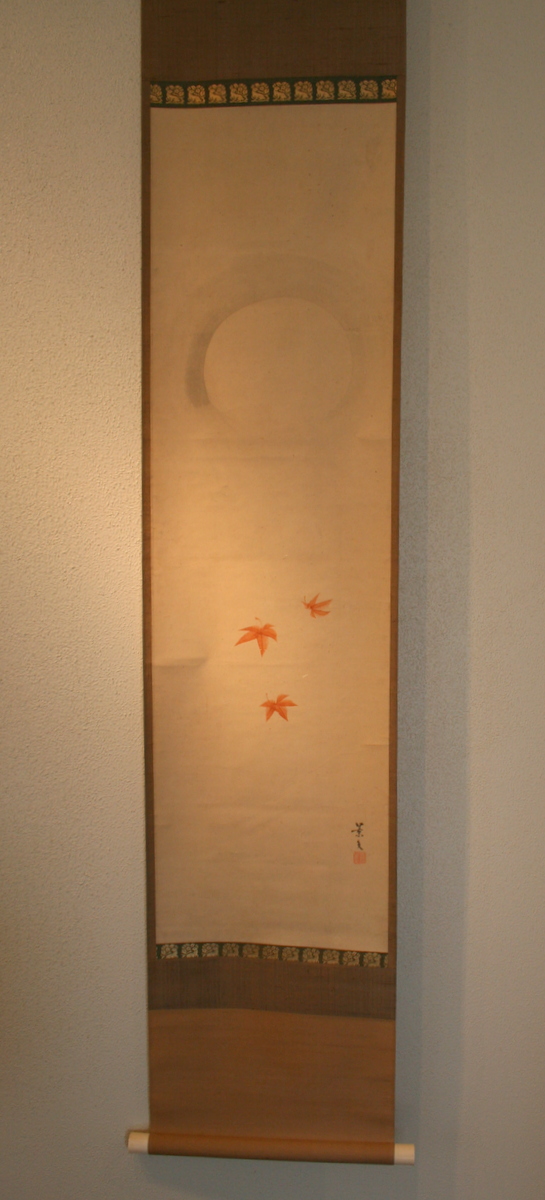 The second element is a scroll depicting a moon with falling maple leaves, possibly from the tree in the summer display. This scroll was painted by Matsumura Keibun 景文 松村 (1779 – 1843) “He was a leading figure in the Shijo school established by his half-brother, Matsumura Goshun (1752-1811). Their father, a fourth-generation official of the Kyoto gold mint, died when Keibun was two years old, making it likely that he would follow Goshun, 27 years his senior, into an artistic career. Keibun mastered the techniques of painting taught at Goshun’s studio at Shijo-Sakaimachi in Kyoto. He studied the work of Maruyama Okyo (1733–1795), whose blend of realism and decorative beauty exerted a major influence on him. Keibun’s numerous sketchbooks reveal his lifelong adherence to Okyo’s dictum to draw from nature. Additionally, he was familiar with Chinese literati painting (Bunjinga) and art theories of the Ming (1368–1644) and Qing (1644–1911) periods. In his later years he associated with Koishi Genzui (1793–1865), a leading figure of Confucian literati circles in Kyoto. In 1797 Keibun’s work was chosen for exhibition by the leading literati scholar and painter, Minagawa Kien (1734–1807) who from 1792 sponsored twice-yearly exhibitions of new works of painting. By 1801 his designs were being included with those of Goshun and other Kyoto artists in woodblock-printed picture-books (ehon). After Goshun’s death in 1811 Keibun shared the leadership of the Shijo school with fellow-pupil Okamoto Toyohiko (1773-1845), and the two became the most popular painters in Kyoto. Keibun was particularly noted for his bird-and-flower (kacho) compositions.(MyJapanesehanga.com)
The second element is a scroll depicting a moon with falling maple leaves, possibly from the tree in the summer display. This scroll was painted by Matsumura Keibun 景文 松村 (1779 – 1843) “He was a leading figure in the Shijo school established by his half-brother, Matsumura Goshun (1752-1811). Their father, a fourth-generation official of the Kyoto gold mint, died when Keibun was two years old, making it likely that he would follow Goshun, 27 years his senior, into an artistic career. Keibun mastered the techniques of painting taught at Goshun’s studio at Shijo-Sakaimachi in Kyoto. He studied the work of Maruyama Okyo (1733–1795), whose blend of realism and decorative beauty exerted a major influence on him. Keibun’s numerous sketchbooks reveal his lifelong adherence to Okyo’s dictum to draw from nature. Additionally, he was familiar with Chinese literati painting (Bunjinga) and art theories of the Ming (1368–1644) and Qing (1644–1911) periods. In his later years he associated with Koishi Genzui (1793–1865), a leading figure of Confucian literati circles in Kyoto. In 1797 Keibun’s work was chosen for exhibition by the leading literati scholar and painter, Minagawa Kien (1734–1807) who from 1792 sponsored twice-yearly exhibitions of new works of painting. By 1801 his designs were being included with those of Goshun and other Kyoto artists in woodblock-printed picture-books (ehon). After Goshun’s death in 1811 Keibun shared the leadership of the Shijo school with fellow-pupil Okamoto Toyohiko (1773-1845), and the two became the most popular painters in Kyoto. Keibun was particularly noted for his bird-and-flower (kacho) compositions.(MyJapanesehanga.com)
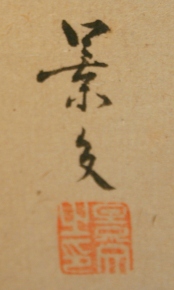 Signature and chop of Matsumura Keibun.
Signature and chop of Matsumura Keibun.
 The third and last component is an accent planting of Sumac, Rhus copallium, in fall color with fern, Selaginella sp.
The third and last component is an accent planting of Sumac, Rhus copallium, in fall color with fern, Selaginella sp.
This display was only installed for a few days as the Sumac quickly dropped its leaves. Fall is a wonderful time to create displays as trees and plants are changing color on a daily basis.
On that note, our annual Fall bonsai exhibit opens tomorrow, Saturday October 20th and continues through November 4th.
Please subscribe to this blog in order to receive updates of new posts, to support the N.B.P.M., and to help me know how many people are reading. Thanks!

You must be logged in to post a comment.